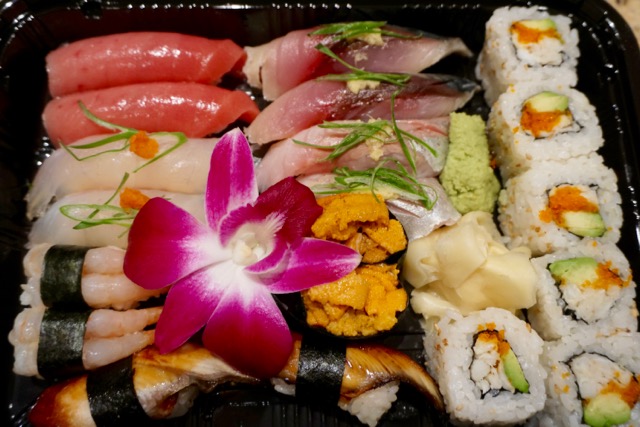Chef Kudo opened a new Izakaya/Sushi bar and creatively named it… “Tako Grill”. The place is very spacious with light wood inside. A wide wooden counter with his working area immediately behind and the kitchen is hidden from view by a purple “Noren” のれん. He and his help were wearing the same Tako grill T-shirts and the cover of the menu is also the same as one in Bethesda (although Kudo did not offer the menu and we did not need it as he served what was the best and what we would like).

He looked the same but a bit thinner. For sake, Kudo offered the local sake from Kuroishi; Kikunoi Honjozo Genshu “Akiagari” 菊乃井 本醸造原酒 ”秋あがり”. This was a nice dry crisp unpasteurized genshu sake with lots of “umami” flavors. We liked it very much.
As we engaged in some catching up, he started serving us a series of excellent dishes. Otoshi お通し was a small local vegetable somewhat similar to small “fuki” ふき but we were told that this was a totally different local vegetable (I do not recall the name).
Sanma さんまor Pacific saury, sashimi was the best we ever had.

Okoze オコゼ or stonefish was the next offering. This is a rather unattractive looking fish from which he carefully removed the venomous dorsal fin (picture below) and then deep fried. we enjoyed the whole fish; bone, head and all.


Since this was “Tako” grill, we had to have “Tako” 蛸 or octopus. Kudo first offered us slices of octopus legs with “sumiso” 酢味噌 dressing. Somehow, the quality of the octopus was different from what we usually get in the U.S.; it was succulent and soft not rubbery or chewy. Then he took out the fresh octopus leg saying this leg was still alive and prepared for us fresh “tako no sashimi” 生蛸の刺身 (below picture). As he slapped each slices down, the muscle contracted. We have had fresh octopus sashimi before in Kobe 神戸 but this one was totally different. The one we had in Kobe was slices of the leg and had a very soft consistency but this one appeared to be the suckers (skin carefully removed) and had nice firm consistency and sweet taste. We were already on the second round of sake.


Our memory was getting fuzzy around this time forward but we had grilled and straw “wara” 藁 smoked sanma. We usually do not like innards but this was an exception. The sanma was fresh to begin with and the way this was prepared was great. Nice smoky flavor and the bitter taste of the sanma innards were perfect combination between the sips of cold sake. We also had a local nice large succulent oysters. What a treat!
Then came the “Piece de resistance”. We discussed the great things Kudo served us at Tako Grill in Bethesda and mentioned “squid okizuke” イカの沖漬け he had served us one time and how much we loved it. Without a pause, he wheeled out a container with fresh “squid innards” okizuke he had prepared (below). Actually, the first serving was consumed so quickly between my wife and I that I did not have a chance to even take a picture. Kudo gave us the second serving and we managed to restrain ourselves long enough to snap the pic.

At this point we were quite full and feeling full effects of the sake. He served us a few pieces of nice nigiri. He then joined us with a glass of his own sparkling sake and we chatted. He appeared happy to be back to his furusato 故郷 (home town).
Finally we had to say good night. He called us a taxicab and we went back to our “hotel” called “Takara onsen” 宝温泉meaning “Treasure hot spring”. Kudo arranged our stay there. This is the first time we had a room with our own private “onsen” attached running steaming hot water 24/7. But this is a long and separate story to tell.
We are glad we visited Tako grill in Kuroishi. We wish Kudo all the best. With food that great, he should prosper and we can visit him again in the near future.









































